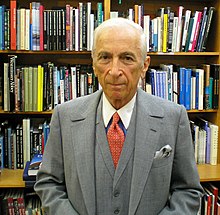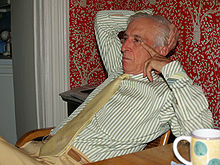Gay Talese
Gay Talese (born February 7, 1932 in Ocean City , New Jersey ) is an American journalist and writer. He wrote for The New York Times in the early 1960s and is considered a co-founder of literary journalism and a movement in journalism also known as New Journalism , according to a collection of articles by Tom Wolfe . His most famous articles are the portraits of Joe DiMaggio , Dean Martin and Frank Sinatra , published in Esquire .
His books, published after several years of research, including the bestseller Honor Thy Father about a mafia family and his book about the sexual revolution in America, Thy Neighbor's Wife , are considered prime examples of New Journalism.
Talese teaches the Master of Professional Writing Program at the University of Southern California each spring .
biography
Gay Talese was born in Ocean City, south of Atlantic City, to a Roman Catholic family of Italian Americans . His father Joseph Talese, who immigrated from southern Italy in 1922, was a tailor, his mother Catherine Talese, née DePaolo, was a saleswoman at the Brooklyn Department Store chain . Talese felt like an outsider from the start because, as an Italian Catholic, he lived on an island full of Protestant Anglo-Saxons , where the few other Catholics were Irish immigrants .
At school, he was also cut for years because he wore tailored suits that were sewn in his father's tailor shop and made him look older than his classmates. He reflected on this time in the autobiographical text Origins of a Nonfiction Writer (1996) and later in the book Unto the Sons . Talese graduated from Ocean City High School in 1949 .
Origins of the journalist career
school
His career as a journalist began at the age of 15 when the coach of the baseball team at his school gave him the job of keeping the local newspaper up to date with the game. Talese accepted the task in the hope of tuning the coach down and being used as a player for longer. After just seven sporting goods, the newspaper, enthusiastic about his way of writing, gave him his own weekly column . By the time he graduated from college in 1949, Talese had written 311 articles and columns for the Ocean City Sentinel Ledger .
Talese based his interview technique on his mother, which later helped him conduct successful interviews with partners as diverse as Mafia members or middle-class Americans whom he asked about their sexual behavior. He explained it like this:
“I learned [from my mother]… to listen with patience and attention and never to interrupt people, even when people spoke hesitantly and imprecisely because they had great difficulty expressing themselves… that is precisely what is very revealing - what people hesitate about telling them can say a lot about them. Their pauses, their excuses, their sudden changes of subject are signs of what makes them embarrassed, disturbed or indicates what they consider too private or too sensitive to share with another person at this point in time. "
college
After high school, Talese studied journalism and history at the University of Alabama . In college, Talese began to use literary means for his reports, such as depicting scenes with minute detail or by jumping into medias res at the beginning of the article . In his freshman year he became the sports editor of the campus newspaper Crimson-White and started a column he called Sports Gay-zing.
Above all, Talese reported on the losers and the strangers. He was more interested in those who did not reap the glory of victory and less in hero worship for the victors.
Working life
Journalist and reporter
After graduating from university in June 1953, he moved to New York , where he initially only found work as an office clerk at the New York Times. Even for this simple job, he wore suits tailored by his father. On the occasion of the "Times Square Anniversary" on November 2, 1953, he interviewed the man who was responsible for the headlines that are shown on the large billboard in Times Square .
His beginning journalistic career was interrupted when he was drafted into the United States Army in 1954 . During his time at the University of Alabama, like all male students during the Korean War, he had been enlisted in the Reserve Officer Training Corps (ROTC). He had moved to New York, where he expected to eventually be promoted to second lieutenant . Talese was called up to Fort Knox to be trained with a tank unit. Because his technical skills were inadequate, he was transferred to the Office of Public Information , with which he was again active as a reporter for the "local newspaper" - the newspaper Inside the Turret . Soon he got his own column called "Fort Knox Confidential".
Talese kept in touch with his former employer, the Times, and when he finished his military service in 1956 he was able to start working there as a sports reporter. He later said: “Sport - it's about people who lose, lose and lose. They lose games and then they lose their jobs. That can be very interesting. ” Of the various sports, boxing was particularly interesting for Talese because people there are in direct competition and the boxers in the price wars of the mid and late fifties were more and more non-whites. Talese alone wrote 38 articles about the black US world boxing champion Floyd Patterson .
Journalist and writer
After a year in the obituary section of the Times , he began to write articles for the Sunday edition of the New York Times , which was produced by its own editorial team under editor-in-chief Lester Markel. In addition to this activity, Talese wrote a report with The Bridge in 1964 about the construction of the Verrazzano-Narrows Bridge in New York City.
Taleses article about Frank Sinatra , published in Esquire in 1966 , " Frank Sinatra Has a Cold ", is one of the most influential American magazine articles of all time and is - since it deals with the singer unwilling to interview exclusively about people of his entourage from their respective point of view - as exemplary for the movement of New Journalism . For the magazine's 50th birthday in 1983, "Frank Sinatra Has a Cold" was voted the best Esquire article of all time. In 1966 Esquire Talese's acclaimed article on Joe DiMaggio, The Silent Season of a Hero , was part of a meditation on the transience of fame. A collection of Talse's articles in Esquire later appeared in the book Fame and Obscurity . In the preface, Talese paid tribute to two scribes he admired: Irwin Shaw and John O'Hara . Both would have encouraged him in his endeavor to use a style in reports similar to that used in their short stories.
Based on his 1971 book Honor Thy Father , which is considered one of the first major reports on the Mafia, a film feature was made. Talese was able to write this book because he won the trust of Mafia boss Salvatore Bill Bonanno , whom he accompanied with interviews for six years and was able to question other mafia figures and soldiers alongside him. His report, The Voyeur's Motel , published in 2016, was criticized even before it was published for the fact that Talese was twisting the facts here and was more likely to have written a novel.
Talese is married to Nan Talese , a New York editor who works for Doubleday Publishing . Gay and Nan Talese's marriage will be the subject of the next volume of Gay Talese's autobiography. The first two volumes of his biography, Unto the Sons and A Writer's Life , appeared in 1992 and 2006.
In the comic
Gay Talese appears in several stories on the Doonesbury comic strip in which he gives a radio interview on his book Thy Neighbor's Wife .
Works (selection)
- The Bridge: The Building of the Verrazano-Narrows Bridge . 1964
- The Kingdom and the Power . 1969, a report on The New York Times
- Fame and Obscurity . 1970
- Honor Thy Father . 1971, published in German as an honor to your father .
- Thy Neighbor's Wife . 1981, in German as you should desire - published on the trail of the sexual revolution .
- Unto the Sons . 1992, Talese tells the story of his own family and their immigration from Italy to America, starting with his great-grandfather.
- Origins of a Nonfiction Writer . 1996
- A Writer's Life . 2006
-
The Voyeur's Motel . 2016
- The voyeur . Translation by Alexander Weber. Hamburg: Tempo, 2017 ISBN 978-3-455-00099-3
Report collections:
- Frank Sinatra has a cold. Spectacular stories from four decades . Rogner and Bernhard, Berlin 2005, ISBN 978-3-8077-1011-2 .
- High notes . Translation by Alexander Weber. Hamburg: Tempo, 2018, ISBN 978-3-455-00288-1 .
Web links
- Literature by and about Gay Talese in the catalog of the German National Library
- Gay Talese website
- Interview by David Shankbone with Gay Talese in the English language Wikinews
- Review by Guy Taleses published in German Report anthology Frank Sinatra has a cold from Beate Berger on Deutschlandfunk
- The text by Frank Sinatra has a cold in the English original of the Esquire
- NZZ article from August 24, 2012
Individual evidence
- ↑ "THE ULTIMATE NEW JERSEY HIGH SCHOOL YEARBOOK: TZ AND ALSO ..." , The Star-Ledger , June 27, 1999. Published August 4, 2007.
- ↑ Archive link ( Memento of the original dated February 5, 2007 in the Internet Archive ) Info: The archive link was inserted automatically and has not yet been checked. Please check the original and archive link according to the instructions and then remove this notice.
- ↑ Archive link ( Memento of the original from January 7, 2010 in the Internet Archive ) Info: The archive link was inserted automatically and has not yet been checked. Please check the original and archive link according to the instructions and then remove this notice.
- ↑ Jrg Häntzschel: Inconsistencies , in: Süddeutsche Zeitung , July 5, 2016, p. 12
- ^ The Life and Love (s) of Gay Talese. ABCNews.com , Aug 10, 2007.
| personal data | |
|---|---|
| SURNAME | Talese, gay |
| BRIEF DESCRIPTION | American journalist and author |
| DATE OF BIRTH | February 7, 1932 |
| PLACE OF BIRTH | Ocean City, New Jersey , USA |

